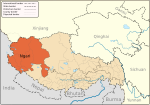Purang County
Burang County
普兰县 • སྤུ་ཧྲེང་རྫོང་། | |
|---|---|
 Gurla Mandhata 7,694 metres (25,243 ft) | |
 Location of Burang County within Tibet | |
| Country | People's Republic of China |
| Autonomous region | Tibet |
| Prefecture | Ngari Prefecture |
| Seat | Burang Town |
| Area | |
| • Total | 12,497 km2 (4,825 sq mi) |
| Population | |
| • Total | 9,657 |
| • Density | 0.77/km2 (2.0/sq mi) |
| 2010 Census | |
| Time zone | UTC+8 (China Standard) |
| Purang County | |||||||||||
|---|---|---|---|---|---|---|---|---|---|---|---|
| Chinese name | |||||||||||
| Simplified Chinese | 普兰县 | ||||||||||
| Traditional Chinese | 普蘭縣 | ||||||||||
| |||||||||||
| Tibetan name | |||||||||||
| Tibetan | སྤུ་ཧྲེང་རྫོང་། | ||||||||||
| |||||||||||
Burang County (Template:Lang-bo; Chinese: 普兰县) is called Purang in Tibetan, and the county capital is also known as Burang or Purang in Tibetan and Taklakot in Nepali.[1] It is an administrative division of Ngari Prefecture in the Tibet Autonomous Region (TAR) of China.
Borders
Burang County has TAR's south-western border with Nepal's Karnali Zone, Humla District. Further west, India's Uttarakhand State, Pithoragarh district borders. Buddhist, Hindu and Jain pilgrims going to Lake Manasarovar and Mount Kailash enter from Nepal via Simikot,[2] and from India via Dharchula.[3]
Beyond the border with India, the county is bounded by other Ngari Prefecture counties Zanda to the west, Gar to the northwest and Gê'gyai to the north. To the east is Gamba County of Shigatse Prefecture.
Natural environment
It covers an area of 12,497 square kilometres (4,825 sq mi) and has a population of some 9,657 people (2010 Census). Its capital and county seat is in Jirang which is located only 20 kilometres (12 mi) from Nepalese territory but some 450 kilometres (280 mi) north-west of Kathmandu. It is an important Chinese customs point between Tibet, Nepal and India. Much of the county consists of river valleys of mountains and lakes such as the Holy Mountain Kangrinboqê (Mount Kailash), The Naimonany Peak Gunrla and Lake Maponen Yamco Lake Manasarowar. The Karnali River is also a prominent geographical feature of the landscape. Wildlife commonly seen in the far south-western Tibetan county are wild donkeys, wild yaks, yellow goats, antelope, rock goat, lynxes, foxes, leopards and marmots.
History

It seems that the Tegla kar (Lying Tiger fort) near Burang was built during the Zhangzhung dynasty which was conquered by the Tibetan king Songtsen Gampo in the early 7th century CE. It became the main fort of the Burang (Purang) Kingdom, in the 10th century under King Kori, one of the two sons of Tashi Gon, King of the Guge Kingdom. The Guge and Burang kingdoms were separated about the late 11th century, when king Logtsha Tsensong founded an independent realm. In about 1330 the 13th king Sonam De took over the important Malla kingdom (alias Yatse; not to be confused with the Malla dynasty of central Nepal) in western Nepal on the extinction of the local dynasty. The dynasty of Burang kings died out shortly before 1376. The territory was subsequently dominated in turns by the neighbouring kingdoms Guge and Mustang.[4]
Economy
Burang is an important barley-growing region and traditionally barley and salt from the salt lakes to the north of Taklakot made up the bulk of the trade to the south, while rice and a wide range of luxuries were traded back into Tibet from Nepal. The local villagers (known as Burangbas) carried the produce across the ranges into Nepal on caravans of sheep and goats during the summer and autumn.[5] Sheep and goats are fitted with double packs which can carry up to 30 kg (70 lb) of barley or salt on the 3 week journey to the terai or low-lands of Nepal.[6] In winter and early spring the region is often in total isolation, cut off by heavy snow falls.
References
- ^ Gyurme Dorje (1999). Footprnt Tibet Handbook (2nd ed.). Bath, England: Footprint Handbooks. ISBN 978-1-900949-33-0.
- ^ Thubron, Colin (2011). To a Mountain in Tibet. New York: Harper Collins. Retrieved Dec 14, 2013.
- ^ "Kailash Mansarovar Yatra". India Tours Guide. Retrieved 13 December 2013.
- ^ R. Vitali (1996), The kingdoms of Gu.ge Pu.hrang. Dharamsala: Tho.ling gtsug.lag.
- ^ von Fürer-Haimendorf, Christoph. (1975). Himalayan Traders: Life in Highland Nepal, pp. 251-256. John Murray, London. Reprint: 1988 Time Books International. New Delhi.
- ^ Tibet Handbook, p. 352. (1999). Edited by Sarah Thorowgood. Passport Books, Chicago. ISBN 0-8442-2190-2.

